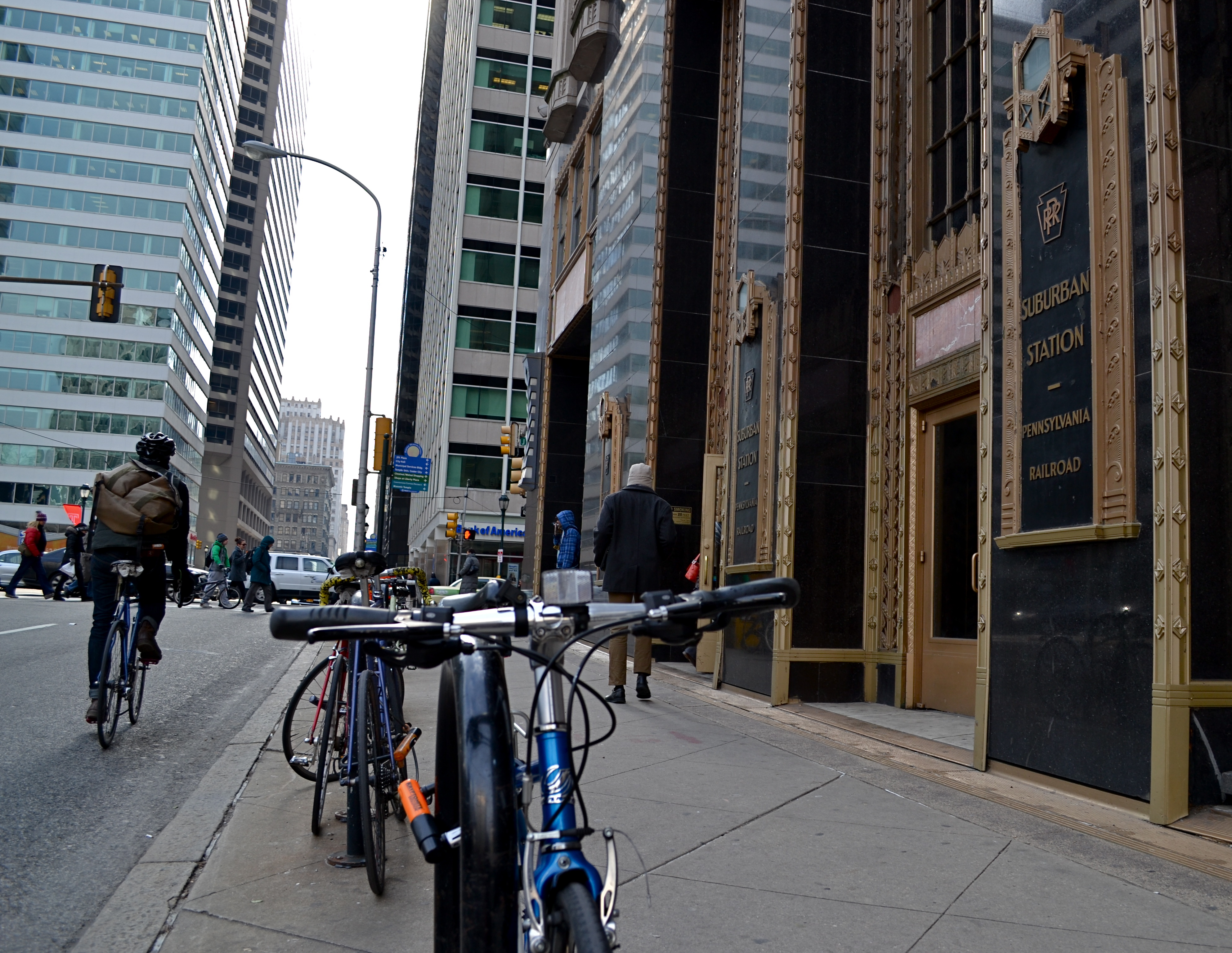Better Mobility 2015: Five no-brainers

BETTER MOBILITY PHILADELHPIA 2015
DRAFT STRATEGIES:
- Bring Philadelphia’s streets and sidewalks into a state of good repair
- Adopt a Vision Zero policy
- Connect the on-street bikeway network
- Build 25 miles of the Circuit
- Improve the walkability of streets and sidewalks
- Prioritize transportation and infrastructure policy and local investment
- Enhance accessibility to public transit
- Ensure access to bike share
- Enliven city streets
- Manage parking efficiently and effectively
What should the next administration do to improve mobility in Philly?
It’s an easy-to read articulation of some very solid goals to make getting around Philly safer and easier while increasing opportunity and vitality.
Through 10 strategies and more than 75 recommendations, Better Mobility Philadelphia 2015 aims to reduce crashes, create more bike lanes and connect the network, improve walkability and transit access, better maintain streets and sidewalks, prioritize transportation and infrastructure policy, enliven streets, better manage on-street parking, and ensure bike share is accessible.
The Bicycle Coalition for Greater Philadelphia developed the platform in collaboration and conversation with partners including Feet First Philly, Clean Air Council, Pennsylvania Environmental Council, Bike Share Philadelphia, University City District, and Center City District.
For every expensive or politically hairy idea in the platform there is a common-sense adjustment. We’ll likely start hearing a lot about Vision Zero – a comprehensive goal to make roads safer for pedestrians, cyclists and motorists – adding more protected bike lanes across the city, expanding pedestrian plazas to every council district, building more trails to help connect the Circuit, and creating better bike parking. We’ll also hear suggestions about improving 311, using data-driven analysis to guide infrastructure investment, and fostering intra-governmental collaboration.
The Bicycle Coalition hosted a listening session for about two dozen attendees Monday evening to discuss the platform, identify weak spots and hot topics, and will accept public comments on the draft through November 21 via email to bike@bicyclecoalition.org.
Some measures will require more public conversation than others but there are a few actionable ideas that are absolute no-brainers to me. Here are five:
Increase automobile registration fee by $5 to fund street maintenance, paving and striping.
[Strategy 1: Bring Philadelphia’s streets and sidewalks into a state of good repair.]
Act 89, Pennsylvania’s new transportation funding bill, allows counties to tack on an additional $5 to fund roadwork. We’d be foolish to leave the possibility of a dedicated funding stream on the table.
This year the Streets Department restored only 24 miles of street surface due to funding constraints, but by its own estimates 130 miles should be its annual target. The money just isn’t there. That’s partly due to the cost of installing ADA-compliant curb ramps, an important benefit that eats away at an already limited paving budget.
Philly needs to fix its 900-mile backlog of streets that are not in a state of good repair. The $5 fee alone won’t solve that problem but it could help make a dent by bringing in around $5 million annually to fund street paving, striping, and maintenance projects.
Well-maintained streets means smoother and safer rides for all, but bike advocates also care about paving and striping because that’s when new bike lanes are most likely to be installed. Less funding and frequency of paving means it’s harder to create the kind of robust bike network our city needs.
Develop, coordinate, and implement a community outreach strategy on bike lane installation; announce new lanes for forthcoming paving seasons and work with Council members on community outreach.
[Strategy 3. Connect the on-street bikeway network]
Resurfacing streets paves the way for new bike lanes, but the city’s political wheels still need oil to ensure that our city’s bike network can become more connected and functional.
The city’s Pedestrian/Bicycle Plan, adopted by the Planning Commission in 2012, outlines where pedestrian and bicycle infrastructure should and can be improved citywide, and City Council authorized the Nutter administration to create a Complete Streets handbook the same year operationalizing many of the Ped-Bike Plan’s goals. But just because City Council voted to support a Complete Streets policy in the abstract doesn’t mean they automatically are sold on the minutiae within. Look no further than a section of the North 22nd Street bike lane that Councilman Bill Greenlee has put the breaks on.
At least for the near future, City Council needs to hear public support for new lanes in order to back them, and that means it’s time for a full court press when it comes to outreach, education, and public input about each new lane proposed.
Advance notice of the paving schedule and possible lane additions, clear public information, and feedback mechanisms are key to smoothing the road for new lanes. Without that we’re stuck with a fragmented bike infrastructure that is less safe for all road users.
Integrate SEPTA and Bike Share farecards
[Strategy 8. Ensure access to bike share]
For Philly Bike Share to be successful, it needs to be treated like part of the city’s public transit network. One of the best ways to do that is to make sure SEPTA’s smartcard system (SEPTA Key) can also be a bike share card. That lowers the barrier to entry, putting bike share in the hands of people who may not have credit cards but are SEPTA riders with smartcards. That is easier said than done, but since SEPTA’s new payment technology and Philly Bike Share have not yet been rolled out, it’s not too late to plan for their integration.
Host a pilot Sunday or Open Streets program during June, July and August 2016
[Strategy 9. Enliven city streets]
There is something wonderful about standing in the middle of the street playing games, splashing, dancing, or riding bikes en masse. The idea of introducing a “summer streets” or “open streets” program, widely used in other cities, is all about getting Philadelphians to experience and use streets in new ways, promoting healthy activity and transportation choices.
Yes, we close down MLK Drive on weekends but a successful open streets series is more than closed roads. It’s about programming.
An Open Streets program that supports exercise and active fun doesn’t have to be expensive, but police costs for street closures and events add up. If the issue with open streets is a matter of cost, perhaps sponsorship should be explored? Sponsors helped programming expand at The Oval this summer.
The more we think about streets as public places for diverse activity, we expand our imaginations about what’s possible on streets. That means more public spaces like pedestrian plazas and parklets become viable interventions to provide safety and make room for community life too.
Strengthen enforcement of zoning that prohibits garages in rowhouse/twin neighborhoods
[Strategy 10. Manage on-street parking for efficient and effective use]
I am unabashedly anti-front loading garage, in no small part because they diminish walkability and the public environment. They prize benefit for one home against the broader public goods of safe pedestrian space on uninterrupted sidewalks. Mobility advocates should care about garages because they distort parking problems and damage our pedestrian-friendly streets.
Front-loading garages require curb cuts that disrupt sidewalks and reduce the supply of public in-street parking that serves more cars in a day than the one residing in the garage. In short garages make street parking more difficult.
You can’t manage parking without controlling supply. Parking is a problem that you do not build your way out of – the more parking capacity you build, the more people are compelled to use their cars. That creates more demand and the pressure for additional parking rises.
In dense, walkable neighborhoods with easy transit access the city’s Zoning Board of Adjustment should be very reticent to let people build front-loading garages where the zoning code does not permit them. These are exactly the places where car use is dropping and we should make fewer public decisions that prioritize cars over people.
WHYY is your source for fact-based, in-depth journalism and information. As a nonprofit organization, we rely on financial support from readers like you. Please give today.






